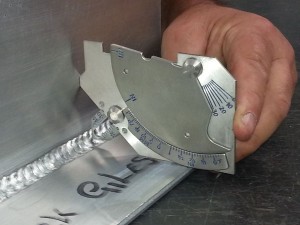Top Benefits of Hiring Welding Inspection Milwaukee for Your Following Work
Top Benefits of Hiring Welding Inspection Milwaukee for Your Following Work
Blog Article
Comprehending the Significance of Welding Examination in Ensuring Structural Integrity and Security Throughout Various Industries
Welding examination is a vital procedure that safeguards structural honesty and security throughout varied sectors. As we check out the details of welding evaluation, the concern develops: what are the most important factors that add to efficient evaluation procedures?
Role of Welding Inspection
While the honesty of bonded frameworks is vital to safety and security and efficiency, the duty of welding evaluation can not be overemphasized. Welding assessment acts as an essential top quality control process that ensures the adherence to established requirements and requirements throughout the welding procedure. By systematically evaluating welds for flaws, variances, and non-compliance, examiners play an important duty in securing the stability of frameworks across various industries.
Welding inspections include a variety of tasks, from pre-weld assessments to post-weld examinations. These analyses not just identify prospective issues before they escalate however also boost the general integrity and life-span of welded components. Welding Inspection Milwaukee. Inspections assist to verify the ability and competencies of welders, ensuring that welding treatments are performed appropriately and products are suitable
Additionally, a rigorous assessment protocol fosters compliance with regulative demands and industry requirements, minimizing the danger of tragic failures. By promoting a culture of safety and security and liability, welding inspection contributes significantly to both financial and functional performances. In sum, the role of welding evaluation is indispensable, as it underpins the top quality, safety and security, and durability of bonded structures necessary to contemporary infrastructure and industry.
Kinds of Welding Inspections
Comprehending the different kinds of welding assessments is important for keeping the high quality and safety and security of welded frameworks. Welding assessments can be categorized right into several types, each offering a particular objective in the examination procedure.
Aesthetic assessment is the most basic kind, involving a mindful examination of the welds with the naked eye or via magnification. This technique aids identify surface area problems such as cracks, insufficient combination, or excessive spatter.
Next is non-destructive screening (NDT), which consists of techniques such as ultrasonic screening, radiographic screening, and magnetic bit testing. These techniques enable examiners to assess the integrity of welds without endangering the product's framework. Ultrasonic testing uses high-frequency audio waves to spot internal flaws, while radiographic testing employs X-rays or gamma rays to picture internal weld attributes. Magnetic particle screening, on the various other hand, works for detecting surface and near-surface gaps in ferromagnetic materials.
Harmful screening, though less common, includes physically checking samples to recognize the weld's mechanical homes. Each sort of evaluation adds to a comprehensive assessment, ensuring that welding meets sector requirements and security needs.
Market Criteria and Regulations
Developing sector criteria and laws is vital for making sure the security and reliability of welded structures. These criteria work as standards for top quality, safety and security, and efficiency, directing manufacturers and inspectors in the execution of welding processes. Numerous organizations, such as the American Welding Culture (AWS) and the International Organization for Standardization (ISO), have actually created comprehensive standards that determine procedures for welding methods, credentials of welders, and examination methods.
Conformity with these policies not only improves the top quality of welds but also decreases dangers associated with architectural failings. Certain codes, such as the ASME Boiler and Pressure Vessel Code, synopsis needs for the building of stress vessels, ensuring they can hold up against functional anxieties. Furthermore, nationwide and neighborhood guidelines commonly mandate adherence to these industry requirements, reinforcing their significance throughout sectors like building, look at this web-site aerospace, and vehicle manufacturing.
Normal updates to these requirements reflect advancements in innovation and welding techniques, making sure that precaution stay pertinent. Therefore, a detailed understanding and execution of these requirements is essential for welding specialists, cultivating a society of safety and top quality in welded structures.
Consequences of Poor Inspections
Inadequate inspections can bring about serious effects in the welding sector, undermining the really policies and criteria developed to ensure Visit Website security and architectural stability. The effects of poor examinations can materialize in different kinds, from immediate security risks to long-term structural failings. Among the most alarming end results is the potential for disastrous crashes, which can lead to significant injury or death. In sectors such as production, aerospace, and building and construction, the effects of low-grade welding can compromise entire structures or parts, leading to costly repair services and substantial downtime (Welding Inspection Milwaukee).
Furthermore, insufficient inspections can taint a company's reputation and outcome in legal repercussions, including fines and lawsuits. Ultimately, the implications of bad inspections expand past specific tasks, impacting industry-wide criteria and public understanding, therefore stressing the vital requirement for efficient and rigorous welding inspections.
Ideal Practices for Effective Examinations
Reliable welding examinations are critical to guaranteeing the stability and safety and security of welded structures. To attain optimal results, examiners must stick to numerous best practices that improve the inspection procedure.

Secondly, inspectors should possess the needed certifications and accreditations appropriate to the welding processes and materials being analyzed. Ongoing training and specialist advancement are crucial to remaining upgraded on market standards and technological improvements.
Additionally, utilizing ideal assessment tools and strategies, such as aesthetic examinations, ultrasonic testing, and radiographic examinations, is crucial for identifying flaws that might endanger structural honesty.
Finally, complete documentation of the examination process is necessary. By executing these best techniques, organizations can substantially boost the efficiency of their welding inspections and guarantee risk-free, trustworthy operations.
Final Thought

Finally, welding evaluation is important for keeping architectural stability and security across various industries. By systematically evaluating welds and adhering to recognized criteria, the assessment procedure reduces dangers related to defects and non-compliance. The application of finest practices in welding assessments not just improves the dependability and lifespan of bonded parts yet also upholds sector policies. Prioritizing reliable welding evaluations is necessary to guarantee the safety and security of personnel, properties, and overall functional stability (Welding Inspection Milwaukee).

As we check out the details of welding evaluation, the question emerges: what are the most crucial aspects that add to effective assessment processes?
Welding examination offers as a vital high quality control procedure that guarantees the adherence to established requirements and requirements throughout the welding procedure. In amount, the duty of welding inspection is vital, as it underpins the top quality, safety and security, and longevity of welded structures necessary to modern-day framework and industry.
Different companies, such as the American Welding Culture (AWS) and the International Company for Standardization (ISO), have established detailed criteria that determine procedures for welding techniques, certification find this of welders, and assessment methods.
Eventually, the ramifications of poor assessments expand past private projects, influencing industry-wide standards and public assumption, hence stressing the essential requirement for strenuous and efficient welding examinations.
Report this page